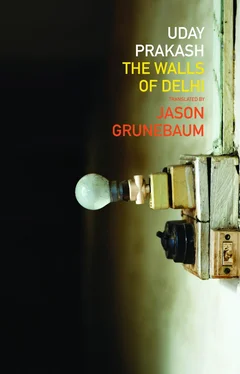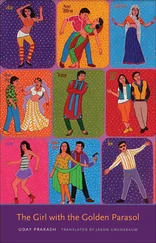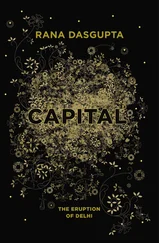‘The Walls of Delhi’ and ‘Mangosil’ — the two ‘city stories’ in this collection — are clearly the work of a writer who has trod extensively through the bylanes of India’s sprawling capital. Still, Prakash shines greatly in his village stories. His poem Tibet, which earned him a prestigious poetry prize at a young age, was inspired by the chanting of Tibetan monks resettled near his village after fleeing the Chinese invasion. ‘Heeralal’s Ghost,’ expertly translated by Robert Hueckstedt, is a fable of a low-caste servant of the village landowner who dies from overwork, then returns as a ghost to terrorise his former employer’s family in episodes both hysterical and tragic. And here, in ‘Mohandas,’ Prakash provides a harrowing portrayal of the caste dynamics and corruption that are still a powerful force in India.
After Prakash picked me up from the airport on that sticky monsoon night in 2005, we spent a week in New Delhi discussing the translation of The Girl with the Golden Parasol. We also spent half a day with his longtime Hindi publisher drinking some twenty cups of tea while in tense negotiations over a decade’s worth of unpaid book royalties. Prakash and I then packed up the car for the three-day trip to Sitapur. From there, we had been invited to the inauguration of a museum in the capital of Chhattisgarh, Rajnandgaon, to be dedicated in part to one of the most important twentieth-century Hindi poets, Muktibodh — a favourite of Prakash’s, and a fellow struggler. At first, Prakash was reluctant to accept the invitation, since the museum and ceremony and publicity all fell under the auspices of the right-wing BJP state government of Chhattisgarh; the Chief Minister of the state — by coincidence, a distant relation of Prakash’s — would be cutting the ribbon. In the end, Prakash decided that it was more important to support recognition of Muktibodh, a man marginalised in his own time, than to keep away from politics he disagreed with.
Muktibodh is the name of the independent-minded judge in ‘Mohandas,’ and we were joined on the trip to Rajnandgaon by Virendra Soni, to whom the story is dedicated. So I suppose I shouldn’t have been surprised that as we were leaving town, Prakash, seeing a man on the road walking toward us, said, ‘Oh, there’s Mohandas.’ And so it was: the man who he had based his character on, looking just as haggard and resilient as described in the story. We stopped, spoke at length, took some photos and went on.
Our host for the festivities was the district collector of Rajnandgaon, who put us up in VIP accommodations at a local chicken magnate’s bungalow. The next day Prakash and other guests read from their work. I will never forget the hundreds of Prakash’s young fans who, hearing he would be in attendance, had travelled long distances and made huge sacrifices to see him in person. In particular, I remember one young man who was unable to walk being carried by four of his friends into the hall. ‘These are my readers,’ Prakash told me.
Though we had assumed that we would attend the museum dedication as spectators, an assistant the next day informed us we would share a dais with the Chief Minister, and that we would be flower-garlanded on stage. In one of the more terrifying moments of my life, once on stage I was instructed to give a speech in Hindi to the thousands assembled. The Chief Minister, speaking last, wasted no time in transforming the oddity of a Hindi-speaking American into political gain: ‘The Congress party may have Sonia Gandhi,’ he told the crowd. ‘But we have Jason! And his Hindi is better than hers.’ ‘We’re here for Muktibodh,’ Prakash whispered to me by way of reassurance after the ribbon-cutting.
In many of his stories, Uday Prakash shows how those who dare to dissent against a suffocating system are punished. But with his biting satire and delightful narrative detours he also demonstrates how humor and compassion ultimately provide the best means to fight back and escape. These two elements combine in stories that are like a mix of Milan Kundera blended with Tristram Shandy — and told by one of the most naturally gifted storytellers writing in any language. Among Hindi writers, Prakash has broken from a strict model of social realism that dominated Hindi fiction for much of the twentieth-century, though he maintains many satirical elements of writers like Manohar Shyam Joshi, while inventing a humor that is all his own. As one prominent Hindi literary critic recently told me, ‘Uday Prakash is knocking on the canon.’ As he continues to knock, he has already spawned a cottage industry of young imitators.
After the publication of ‘Mohandas’ and The Girl with the Golden Parasol, and later, when the Indian national literary body, the Sahitya Akademi, awarded Uday Prakash its highest honour in Hindi for ‘Mohandas,’ and Kindle magazine named him a top South Asian youth icon, the dark days began to recede. Life for Uday Prakash as an independent Hindi writer continues to be difficult and uncertain, but less so. It is his hope to spend much of his time writing in relative peace possibly in Berlin, where his son, daughter-in-law, and grandson live. He is currently at work on several projects, among them a novel entitled Cheena Baba about a Chinese soldier who deserts during the 1962 Indo-China war and makes his home in a tree near the Indian border with Nepal.
***
I have followed a couple of basic strategies in translating these three stories. First, I have tried to make Prakash’s prose sound as contemporary and relevant in English as it does in Hindi without, I hope, sounding over colloquial or slangy. Second, I have attempted to render his prose into an English that is both readable and comprehensible by English speakers not only from the Indian subcontinent, but also from Australia, the US, the UK, and elsewhere. Translators from Hindi and other South Asian languages into English face a problem that translators from, say, French or Spanish don’t have to grapple with. South Asian English can differ in many meaningful ways from the way English is spoken and written in other parts of the world. In addition, English speakers from the Indian subcontinent can usually be expected to understand the cultural context of the stories more readily than someone from Oklahoma or Alice Springs might. Hindi and Indian words, too, from adivasi (a tribal or aboriginal) to zamindar (landowner) would probably need no explanation: if I had been translating exclusively for an Indian audience, the temptation would have been to leave Hindi words like this ‘as is,’ even in the English. But one of the goals of translating is to enlarge the conversation, and conversations don’t work if someone feels left out. Therefore, keeping in mind that the readers of this book will come from a variety of English backgrounds, I have assumed little or no prior knowledge of India or Hindi. In the few instances I have decided to retain words like adivasi or zamindar, I have inserted a brief gloss within the text that should provide readers with sufficient clues as to the meaning. Or, I’ve concluded that enough context already exists for the reader to understand the meaning, if not the gist, of the word or phrase. (I prefer this solution to footnotes or glossaries, which I avoid, since they are not found in the Hindi, and I believe they can give the story an unwanted and unnecessary air of academic writing.) At the same time, I have tried to avoid ‘pre-chewing’ the text too much for South Asians who may be, at least culturally, closer to the Hindi. My greatest hope is that at least some of the enormous pleasure I took in translating these wonderful stories, and the important voice of Uday Prakash, is evident in the English.










